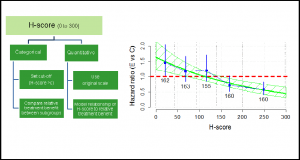 The incorporation of biomarkers into drug development becomes more and more important, as they provide essential information to find the right therapy at the right time for the right patient (“precision medicine”).
The incorporation of biomarkers into drug development becomes more and more important, as they provide essential information to find the right therapy at the right time for the right patient (“precision medicine”).
This talk provided an overview on the roles of prognostic and predictive biomarkers, with a particular focus on (semi-) quantitative markers based on Immunohistochemistry (IHC). For their use in clinical practice, these biomarkers are often categorised via a cut-off value, as it conveniently divides patients into subgroups.
Different statistical models were discussed that identify subgroups of patients, who are most likely to benefit from a targeted therapy. Furthermore, it was illustrated that an analysis on the original scale of the biomarker is useful and necessary, as it provides insights on an individual patient level.

Recent Comments